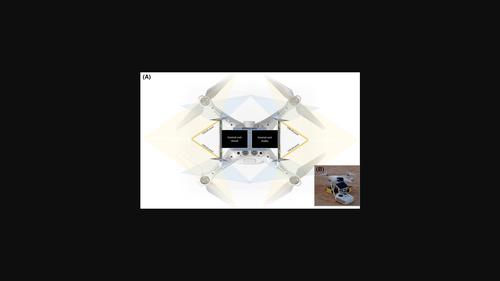Drone‐mounted audio‐visual deterrence of bats: implications for reducing aerial wildlife mortality by wind turbines
IF 3.9
2区 环境科学与生态学
Q1 ECOLOGY
引用次数: 0
Abstract
Wind energy is a major and rapidly expanding renewable energy source. Horizontal‐axis wind turbines, the main tool in this industry, induce mortality in flying animals and consequently bring about conservation concerns and regulatory restrictions. We utilized a unique combination of RADAR, LIDAR and ultrasonic acoustic recorders to test the utility of a novel technology meant to prevent wind turbine‐related mortality in bats. Our drone‐mounted deterrent device produces a pulsating combination of strong auditory and visual signals while moving through the air. LIDAR was used to assess the device's impact below its flight altitude and RADAR to assess its influence above its flight altitude. Continuous acoustic recordings from ground level to ~400 m above‐ground‐level were used to monitor bat activity in the research site. We recorded the nightly altitudinal distributions of multiple bat species throughout the experiment. Analysis revealed a significant change in activity while the deterrent was flying compared to baseline conditions. We also recorded a significant ~40% decrease below and a significant ~50% increase above the deterrent's flight altitude during its operation compared to the post‐flight control. The tested technology is independent of wind farm activities and does not require modifying wind turbine form or operation procedures. The device differs from previously proposed solutions by being dynamic – moving in the airspace and emitting constantly changing signals – thus decreasing the probability of animal habituation. Our findings suggest that the deterrent could dramatically decrease wind turbine‐related mortality by deterring bats from approaching rotor‐swept airspace. Focused implementation in conditions where bat activity and energy production are in conflict may provide a practical, cost‐effective mortality mitigation solution compared to current alternatives. Thus, our results should be considered by the wind‐turbine industry and environmental monitoring and animal conservation organizations, as well as by regulatory agencies, when pursuing alleviation of wind turbine‐related mortality.

无人机对蝙蝠的视听威慑:风力涡轮机对减少空中野生动物死亡率的影响
风能是一种主要且快速发展的可再生能源。水平轴风力涡轮机是该行业的主要工具,会导致飞行动物死亡,从而带来保护问题和监管限制。我们利用雷达、激光雷达和超声波记录仪的独特组合来测试一种新技术的实用性,该技术旨在防止蝙蝠因风力涡轮机而死亡。我们安装在无人机上的威慑装置在空中移动时会产生强烈的听觉和视觉信号的脉动组合。激光雷达用于评估该设备在飞行高度以下的影响,雷达用于评估其在飞行高度以上的影响。从地面到约400米的连续声学记录 m用于监测研究地点的蝙蝠活动。在整个实验过程中,我们记录了多种蝙蝠的夜间海拔分布。分析显示,与基线条件相比,威慑力量飞行时的活动发生了重大变化。我们还记录到,与飞行后控制相比,在威慑物运行期间,其飞行高度显著下降约40%,显著上升约50%。测试技术独立于风电场活动,不需要修改风力涡轮机的形式或操作程序。该设备与之前提出的解决方案的不同之处在于,它是动态的——在空域中移动并发出不断变化的信号——从而降低了动物习惯化的概率。我们的研究结果表明,通过阻止蝙蝠接近旋翼掠过的空域,这种威慑可以显著降低与风力涡轮机相关的死亡率。与目前的替代方案相比,在蝙蝠活动和能源生产发生冲突的条件下重点实施可能会提供一种实用、成本效益高的死亡率缓解解决方案。因此,在寻求降低风机相关死亡率时,风机行业、环境监测和动物保护组织以及监管机构应考虑我们的结果。
本文章由计算机程序翻译,如有差异,请以英文原文为准。
求助全文
约1分钟内获得全文
求助全文
来源期刊

Remote Sensing in Ecology and Conservation
Earth and Planetary Sciences-Computers in Earth Sciences
CiteScore
9.80
自引率
5.50%
发文量
69
审稿时长
18 weeks
期刊介绍:
emote Sensing in Ecology and Conservation provides a forum for rapid, peer-reviewed publication of novel, multidisciplinary research at the interface between remote sensing science and ecology and conservation. The journal prioritizes findings that advance the scientific basis of ecology and conservation, promoting the development of remote-sensing based methods relevant to the management of land use and biological systems at all levels, from populations and species to ecosystems and biomes. The journal defines remote sensing in its broadest sense, including data acquisition by hand-held and fixed ground-based sensors, such as camera traps and acoustic recorders, and sensors on airplanes and satellites. The intended journal’s audience includes ecologists, conservation scientists, policy makers, managers of terrestrial and aquatic systems, remote sensing scientists, and students.
Remote Sensing in Ecology and Conservation is a fully open access journal from Wiley and the Zoological Society of London. Remote sensing has enormous potential as to provide information on the state of, and pressures on, biological diversity and ecosystem services, at multiple spatial and temporal scales. This new publication provides a forum for multidisciplinary research in remote sensing science, ecological research and conservation science.
 求助内容:
求助内容: 应助结果提醒方式:
应助结果提醒方式:


